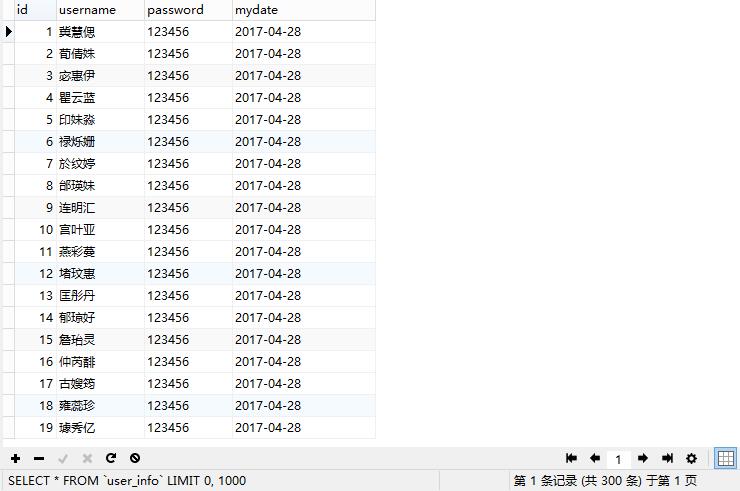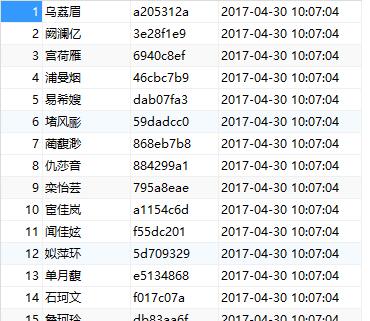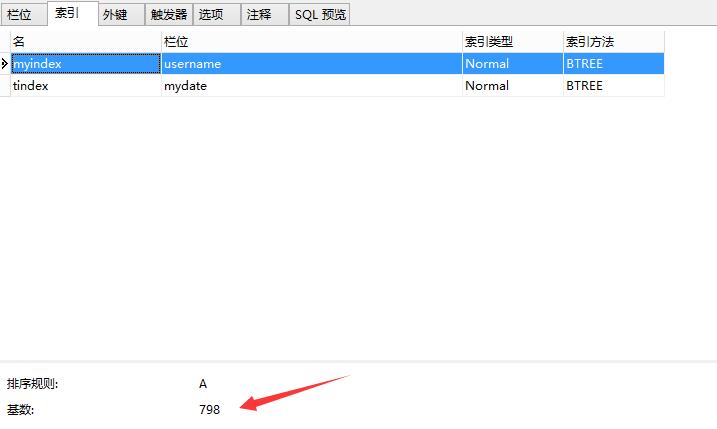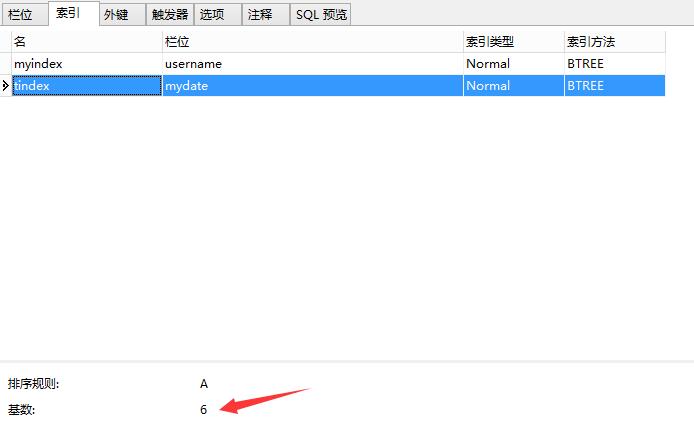MySQL之索引
索引(在MySQL中也叫鍵(key))是存儲引擎用於快速找到記錄的一種數據結構。
索引類型有:Normal,Unique,FullText。
索引方法有:BTREE、HASH。
我有一個user_info的測試表

裏面隨機生成了300個姓名

一、索引基礎
創建一個普通索引:
mysql> create index myindex on user_info(username); Query OK, 0 rows affected Records: 0 Duplicates: 0 Warnings: 0
也可以指定索引的長度:
create index myindex on user_info (username(3));
創建一個唯一索引:
mysql> create unique index uindex on user_info (id); Query OK, 0 rows affected Records: 0 Duplicates: 0 Warnings: 0
創建一個全文索引:(InnoDB引擎對全文索引的支持是5.6版本引入的)
mysql> create fulltext index findex on user_info (username); Query OK, 0 rows affected Records: 0 Duplicates: 0 Warnings: 1
到目前為止創建了三個索引:

可以看出,默認的索引方法是BTREE。
刪除索引:
mysql> drop index findex on user_info; Query OK, 0 rows affected Records: 0 Duplicates: 0 Warnings: 0 mysql> drop index uindex on user_info; Query OK, 0 rows affected Records: 0 Duplicates: 0 Warnings: 0
關鍵詞解釋:
主鍵:當我們創建主鍵的時候,同時分配了一個唯一索引,也就是“主索引”,不過與唯一索引不一樣的是,主鍵用關鍵字Primary 而不是 Unique。
外鍵:一般外鍵字段為某個表的主鍵,關鍵字為Foreign Key
普通索引:這種索引是最基本的索引,作用就是加快數據的訪問速度。
唯一索引:普通索引允許數據列包括重復的數據,而唯一索引不允許。
全文索引:該索引可以用於全文搜索。
二、索引設計的原則
1. 最適合索引的列是出現在where子句後面的列,或連接子句中出現的列。
2. 使用唯一索引。考慮列中值的分布。索引的列基數越大,索引的效果越好。
3. 使用短索引。如果對字符串列進行索引,應該指定一個前綴長度。
4. 利用最左前綴。
5. 不要過度索引。
這裏解釋一下最左前綴:
我創建了一個組合索引:
mysql> create index nindex on user_info (username(3),password(6)); Query OK, 0 rows affected Records: 0 Duplicates: 0 Warnings: 0
實際上我相當於建立了兩個索引,分別是:
username,password
username
而沒有password。
因為這是MySQL組合索引“最左前綴”的結果。簡單理解就是只從最左邊開始組合。
例如:
mysql> explain select * from user_info where username = ‘茹芬慧‘ and password = ‘123456‘; +----+-------------+-----------+------+----------------+---------+---------+-------+------+------------------------------------+ | id | select_type | table | type | possible_keys | key | key_len | ref | rows | Extra | +----+-------------+-----------+------+----------------+---------+---------+-------+------+------------------------------------+ | 1 | SIMPLE | user_info | ref | myindex,nindex | myindex | 767 | const | 1 | Using index condition; Using where | +----+-------------+-----------+------+----------------+---------+---------+-------+------+------------------------------------+ 1 row in set mysql> explain select * from user_info where password = ‘123456‘; +----+-------------+-----------+------+---------------+------+---------+------+------+-------------+ | id | select_type | table | type | possible_keys | key | key_len | ref | rows | Extra | +----+-------------+-----------+------+---------------+------+---------+------+------+-------------+ | 1 | SIMPLE | user_info | ALL | NULL | NULL | NULL | NULL | 300 | Using where | +----+-------------+-----------+------+---------------+------+---------+------+------+-------------+ 1 row in set
第一個使用了索引,d第二個沒有。
三、語句什麽時候執行索引,什麽時候不執行?
為什麽要寫這個,這個標題的意思不是告訴你什麽時候用索引,而是告訴你當你使用索引的時候,索引什麽時候不幹活。
例子1:
mysql> select * from user_info where username like ‘%茹%‘; +-----+----------+----------+------------+ | id | username | password | mydate | +-----+----------+----------+------------+ | 24 | 茹芬慧 | 123456 | 2017-04-28 | | 144 | 茹瑛炫 | 123456 | 2017-04-28 | +-----+----------+----------+------------+ 2 rows in set mysql> select * from user_info where username like ‘茹%‘; +-----+----------+----------+------------+ | id | username | password | mydate | +-----+----------+----------+------------+ | 144 | 茹瑛炫 | 123456 | 2017-04-28 | | 24 | 茹芬慧 | 123456 | 2017-04-28 | +-----+----------+----------+------------+ 2 rows in set
這兩個查詢語句都查出了結果,可是到底有沒有好好幹活呢?
mysql> explain select * from user_info where username like ‘%茹%‘; +----+-------------+-----------+------+---------------+------+---------+------+------+-------------+ | id | select_type | table | type | possible_keys | key | key_len | ref | rows | Extra | +----+-------------+-----------+------+---------------+------+---------+------+------+-------------+ | 1 | SIMPLE | user_info | ALL | NULL | NULL | NULL | NULL | 300 | Using where | +----+-------------+-----------+------+---------------+------+---------+------+------+-------------+ 1 row in set mysql> explain select * from user_info where username like ‘茹%‘; +----+-------------+-----------+-------+---------------+---------+---------+------+------+-----------------------+ | id | select_type | table | type | possible_keys | key | key_len | ref | rows | Extra | +----+-------------+-----------+-------+---------------+---------+---------+------+------+-----------------------+ | 1 | SIMPLE | user_info | range | myindex | myindex | 767 | NULL | 2 | Using index condition | +----+-------------+-----------+-------+---------------+---------+---------+------+------+-----------------------+ 1 row in set
看吧,第一個掃描了全部行,而第二個就令我們滿意了。
mysql> set profiling = 1; Query OK, 0 rows affected mysql> select * from user_info where username like ‘%茹%‘; +-----+----------+----------+------------+ | id | username | password | mydate | +-----+----------+----------+------------+ | 24 | 茹芬慧 | 123456 | 2017-04-28 | | 144 | 茹瑛炫 | 123456 | 2017-04-28 | +-----+----------+----------+------------+ 2 rows in set mysql> select * from user_info where username like ‘茹%‘; +-----+----------+----------+------------+ | id | username | password | mydate | +-----+----------+----------+------------+ | 144 | 茹瑛炫 | 123456 | 2017-04-28 | | 24 | 茹芬慧 | 123456 | 2017-04-28 | +-----+----------+----------+------------+ 2 rows in set mysql> show profiles; +----------+-----------+----------------------------------------------------+ | Query_ID | Duration | Query | +----------+-----------+----------------------------------------------------+ | 1 | 0.0005955 | select * from user_info where username like ‘%茹%‘ | | 2 | 0.000492 | select * from user_info where username like ‘茹%‘ | +----------+-----------+----------------------------------------------------+ 2 rows in set
用了索引的快。
結論一:MySQL能在索引中做最左前綴匹配的LIKE比較,因為該操作可以轉換為簡單的比較操作,但是!如果是以通配符開頭的LIKE查詢,就完蛋了。
例子2:
今天重新生成了一下數據,一共798條

我想測試一下group by。
mysql> select count(*),mydate from user_info group by mydate; +----------+---------------------+ | count(*) | mydate | +----------+---------------------+ | 300 | 2017-04-30 10:07:04 | | 199 | 2017-04-30 10:37:19 | | 299 | 2017-04-30 10:37:34 | +----------+---------------------+ 3 rows in set
把mydate字段加上索引,並再次執行上面的語句
mysql> create index tindex on user_info (mydate); Query OK, 0 rows affected Records: 0 Duplicates: 0 Warnings: 0 mysql> select count(*),mydate from user_info group by mydate; +----------+---------------------+ | count(*) | mydate | +----------+---------------------+ | 300 | 2017-04-30 10:07:04 | | 199 | 2017-04-30 10:37:19 | | 299 | 2017-04-30 10:37:34 | +----------+---------------------+ 3 rows in set
最後,比較加上索引與不加索引的區別
mysql> show profiles; +----------+------------+-----------------------------------------------------------+ | Query_ID | Duration | Query | +----------+------------+-----------------------------------------------------------+ | 1 | 0.0007455 | select count(*),username from user_info group by username | | 2 | 0.003184 | select count(*),password from user_info group by password | | 3 | 0.000651 | select * from user_info where password = ‘aedd902d‘ | | 4 | 0.0002475 | select count(*) from user_info where group by mydate | | 5 | 0.0182485 | select count(*) from user_info group by mydate | | 6 | 0.0012275 | select count(*),mydate from user_info group by mydate | | 7 | 0.00123675 | select count(*),username from user_info group by username | | 8 | 0.2569555 | create index tindex on user_info (mydate) | | 9 | 0.00111575 | select count(*),mydate from user_info group by mydate | +----------+------------+-----------------------------------------------------------+ 9 rows in set
只需要看6和9,雖然索引快了一些,但是基本上可以忽略了,這是因為我mydate字段重復的太多,不利於索引。
結論2:索引的選擇性越高則查詢效率越高,因為選擇性高的索引可以讓MySQL在執行的時候過濾掉更多的行。(選擇性=不重復的索引值(也稱為基數)/數據表的記錄總數)
例如我的:

username的選擇性為1,效率最高

mydate的選擇性為6/798,效率非常差
例子3:
mysql> select * from user_info where id + 1 = 798; +-----+----------+----------+---------------------+ | id | username | password | mydate | +-----+----------+----------+---------------------+ | 797 | 燕淞可 | 3e68fcdd | 2017-04-30 10:37:34 | +-----+----------+----------+---------------------+ 1 row in set mysql> select * from user_info where id = 797; +-----+----------+----------+---------------------+ | id | username | password | mydate | +-----+----------+----------+---------------------+ | 797 | 燕淞可 | 3e68fcdd | 2017-04-30 10:37:34 | +-----+----------+----------+---------------------+ 1 row in set
這兩條查詢語句代表的意思一樣,但是執行起來就一樣嗎?效率差太多了
mysql> show profiles; | 11 | 0.00116025 | select * from user_info where id + 1 = 798 | | 12 | 0.000483 | select * from user_info where id = 797 |
查看Explain
mysql> explain select * from user_info where id + 1 = 798; +----+-------------+-----------+------+---------------+------+---------+------+------+-------------+ | id | select_type | table | type | possible_keys | key | key_len | ref | rows | Extra | +----+-------------+-----------+------+---------------+------+---------+------+------+-------------+ | 1 | SIMPLE | user_info | ALL | NULL | NULL | NULL | NULL | 798 | Using where | +----+-------------+-----------+------+---------------+------+---------+------+------+-------------+ 1 row in set mysql> explain select * from user_info where id = 797; +----+-------------+-----------+-------+---------------+---------+---------+-------+------+-------+ | id | select_type | table | type | possible_keys | key | key_len | ref | rows | Extra | +----+-------------+-----------+-------+---------------+---------+---------+-------+------+-------+ | 1 | SIMPLE | user_info | const | PRIMARY | PRIMARY | 4 | const | 1 | NULL | +----+-------------+-----------+-------+---------------+---------+---------+-------+------+-------+ 1 row in set
這是因為如果查詢的列而不是獨立的,就不會使用索引。“獨立的列”指的是:不能是表達式的一部分,也不能是函數的一部分。
結論三:查詢的列需要獨立
例子4:
前綴索引,什麽時候用呢。對於BLOB,TEXT或者很長的Varchar,我們就不得不使用前綴索引了,並且MySQL不允許索引這些列的完整長度。
但是!對於前綴索引,多長才合適呢?
首先,計算完整列的選擇性:
mysql> select count(distinct password)/count(*) from user_info; +-----------------------------------+ | count(distinct password)/count(*) | +-----------------------------------+ | 1.0000 | +-----------------------------------+ 1 row in set
(⊙o⊙)…這是個失誤,都怪我這個生成的都好唯一啊。那就幹講吧。
完整列的選擇性 = (目標列不重復數目)/(數據總數)
然後計算前綴的選擇性,並且讓前綴的選擇性接近完整列的選擇性。
前綴的選擇性 = count(distinct left(【列名】,【長度】))/(數據總數)
前綴的選擇性需要去換數值一個一個試的。
等你找到了合適的長度,就可以添加這個索引了
create index yourindex on yourtable (yourcol(yourlength));
不過無法用前綴索引做Group By 和Order By。
結論四:如果需要索引很長的字符列,那就使用前綴索引
例子5:
最近比較忙,未完待續...
MySQL之索引
